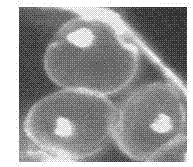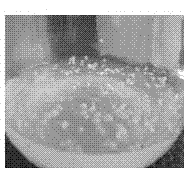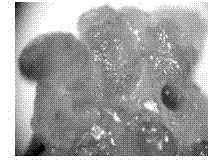Method for obtaining haplobiont through inducing sporidia of eustoma grandiflorum
A microspore and haploid technology, applied in the fields of botany equipment and methods, horticultural methods, plant regeneration, etc., can solve the problem of difficulty in obtaining inbred parent plants, high production cost of fresh cut flowers, and dependence on imports of eustoma hybrid seeds, etc. problems and achieve the effect of huge potential commercial value
- Summary
- Abstract
- Description
- Claims
- Application Information
AI Technical Summary
Problems solved by technology
Method used
Image
Examples
Embodiment 1
[0027] The method for obtaining haploid plants by induction of free microspores of Shelley (champagne color) is as follows:
[0028] (1) Determining the material: Select the hybrid first-generation Eustoma Shelley (champagne color) with comprehensive and excellent properties as the test material.
[0029] (2) Bud selection, pretreatment, and disinfection: In the early stage of flowering, select flower buds in the single-nucleus marginal stage under a microscope by fluorescent staining, put them in a plastic bag and place them in a refrigerator at 4°C for 1 to 3 days, and wash them with detergent. Clean the surface of the flower buds and rinse them with clean water; disinfect with 75% alcohol for 60 sec, then disinfect with 0.1% mercury chloride for 10-15 minutes, and finally rinse with sterile water for 3 times and dry them in the air.
[0030] (3) Separation of free microspores: Grind the sterilized flower buds in a mortar containing B5 medium, filter the mixture through ...
Embodiment 2
[0042] The method of inducing haploid plants from Senna (purple) free microspores is as follows:
[0043] (1) Determine the material: select the first-generation hybrid eustoma Senna (purple) with comprehensive and excellent properties as the test material;
[0044] (2) Bud selection, pretreatment, disinfection: the same as in Example 1
[0045] (3) Separation of free microspores: the same as in Example 1
[0046] (4) Microspore callus induction: same as Example 1, while solid layer: MS + 0.8% agar powder + 3% sucrose, liquid layer: MS + 2 mg / L KT + 2 mg / L 2,4- D+3% sucrose;
[0047] (5) Adventitious bud induction: same as Example 1, but adventitious bud induction medium MS+2mg / L KT+0.5mg / L IBA;
[0048] (6) Haploid plants are obtained the same as in Example 1
[0049] (7) Ploidy identification of regenerated plants is the same as in Example 1. But the control plant of first-generation eustoma imported from abroad is Saina (purple).
Embodiment 3
[0051] The method of obtaining haploid plants induced by free microspores of myth (purple fringe) is as follows:
[0052] (1) Determining the material: Select the hybrid first-generation eustoma (purple fringe) with comprehensive and excellent traits as the test material;
[0053] (2) Bud selection, pretreatment, disinfection: the same as in Example 1
[0054] (3) Separation of free microspores: the same as in Example 1.
[0055] (4) Microspore callus induction: same as Example 1, while solid layer: MS + 0.8% agar powder + 3% sucrose; liquid layer: MS + 1 mg / L KT + 2 mg / L 2,4-D +3% sucrose;
[0056] (5) Adventitious bud induction: same as Example 1, but adventitious bud induction medium MS+1mg / L KT+0.2mg / L IBA;
[0057] (6) Haploid plants are obtained the same as in Example 1
[0058] (7) Ploidy identification of regenerated plants is the same as in Example 1. But the control plant of the first-generation eustoma imported from abroad is a myth (purple fringe).
PUM
 Login to View More
Login to View More Abstract
Description
Claims
Application Information
 Login to View More
Login to View More - R&D
- Intellectual Property
- Life Sciences
- Materials
- Tech Scout
- Unparalleled Data Quality
- Higher Quality Content
- 60% Fewer Hallucinations
Browse by: Latest US Patents, China's latest patents, Technical Efficacy Thesaurus, Application Domain, Technology Topic, Popular Technical Reports.
© 2025 PatSnap. All rights reserved.Legal|Privacy policy|Modern Slavery Act Transparency Statement|Sitemap|About US| Contact US: help@patsnap.com



